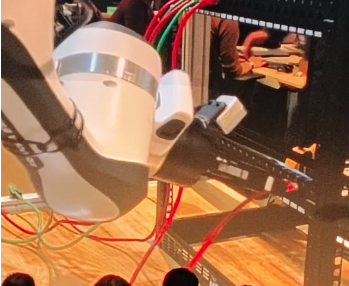Is Palletizing Robot Speed Fast Enough? The Truth About Fast Robots

Posted on May 10, 2022 in Palletizing
5 min read time
You watch a video of a palletizing robot online. And you think… isn't that too slow!? What is an acceptable palletizing robot speed for a business like yours?
It's easy to find videos of fast-moving robots. For example, you might see a delta robot moving at lighting-quick speeds in a food manufacturing environment. You can also find plenty of videos of high-volume palletizing automation in mass-production facilities.
When you see a collaborative robot doing a task like palletizing, it can seem like a bit of an anticlimax.
Collaborative robot seem to move slowly. Although the robots themselves can move as fast as many conventional industrial robots, we usually run them at a more modest pace. This is generally for safety reasons — slower moving robots are safer around humans. But, often, you just don't need your palletizing robot to be moving super-fast.
Let's have a look at the truth about fast robots for palletizing.
Do you need a super fast robot?
People sometimes make a comparison between "hard, fast industrial robots" vs "soft, slow collaborative robots."
If your production is being held up by your palletizing task, you might think, "We have lots of boxes to palletize and we need to do it quickly! We must need the fastest palletizing robot on the market!"
The question you need to ask yourself is… do you? Do you really need the fastest palletizing robot?
As human beings, we often equate speed with productivity.
The problem is that working faster doesn't necessarily mean we get more work done. Slowing down can often make us more productive. This is true when we are working in our offices and it is also true for robotic automation.
Having a slower palletizing robot that works at a clear, consistent speed can actually make your business more efficient.
Unless you absolutely need a super-fast palletizing operation, slow and steady might just win the race.
3 factors that are more important than cobot speed
If speed isn't so important for many palletizing tasks… what is important?
What factors should you prioritize instead when you move to an automated palletizing process?
Here are 3 factors that are at least as important as the robot's speed… and probably far more important:
1. Underutilization of human potential
There are 8 core wastes of any manufacturing process. The first 7 wastes are the same as those that the Lean Manufacturing framework focuses on: transportation, waiting, overproduction, defects, inventory, movement, and extra processing.
The 8th waste of manufacturing is one that is specific to robotics. It is the underutilization of human potential. Palletizing as a job doesn't make the best use of the talents of your people. It's usually much more valuable to move the people away from the manual palletizing task and onto more rewarding, value-added jobs.
2. Context — consistency vs speed
Some people say that collaborative robots are slow. We say… compared to what?
Is the cobot slower than a human worker who works as fast as possible at their optimal level? Yes, probably.
Is the cobot slower than a human when they are tired at the end of a shift? Maybe, but probably not.
Is the cobot slower than a human when they are taking a lunch break or have gone home for the day? Definitely not!
The major benefit of using a robot for palletizing is not about doing the task quickly. Instead, it is about providing a consistent palletizing operation. The robot can achieve the same speed and quality for hours on end.
.jpg?width=798&name=Palletizing_Application%20(1).jpg)
3. Your specific palletizing requirements
Perhaps you need the fastest automated palleting solution that money can buy. If so, you are probably a mass-production operation and you should invest in custom-built automation.
If your business is like most, however, your palletizing needs will be more modest.
Do you really need all your boxes to be palletized in just 20 minutes?
What will the robot do after it palletizes all the boxes?
Any time the robot is sitting idle, it is not earning a return on investment. It's important to be brutally realistic about your requirements for the palletizing task.
A better way to understand robot speed for palletizing
Adding a palletizing robot to your operations is all about achieving balance. You don't want the robot to be working at top speed for a short period, then gather dust for the rest of the day. It's much better to be consistent.
An added benefit of having a slow but consistent robotic palletizing operation is that it can set the pace for the rest of your operation.
We have seen examples of companies where adding a palletizing robot has prompted human workers to try to "keep up" with the robot. Because the robot wasn't working at impossibly fast speeds, it encouraged people to just slightly raise their own work speed. They ended up performing their tasks more consistently thanks to the robot.
Start with the palletizing robot speed you really need
Instead of fixating on the speed of the robot, start by looking at the properties you will actually need.
You might look at factors like:
- The size of boxes or objects for palletizing.
- The throughput you require consistently.
- The payload requirements of the palletizing robot.
- The number of simultaneous pallets you want to fill.
- Other processing tasks you want the robot to do (e.g. sticking labels, sorting boxes, tracking items).
It can also be helpful to calculate the return on investment for your robotic palletizing compared to the manual palletizing task. This shows another perspective on the benefit of robotic palletizing that isn't all about the robot's instantaneous speed.
Check out our dedicated palletizing page for more information.
What do you think about the speed of palletizing robots? Tell us in the comments below or join the discussion on LinkedIn, Twitter, Facebook, or the DoF professional robotics community.








Leave a comment